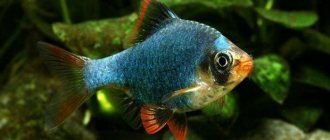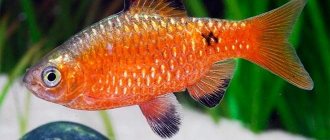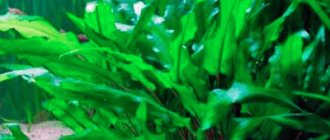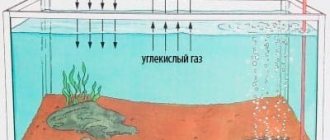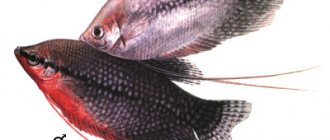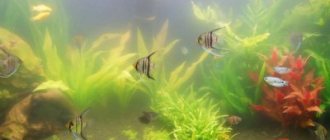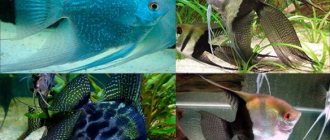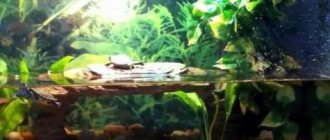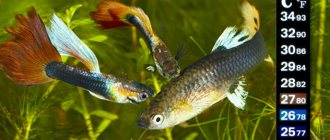4.9
(98)
When a person wants to start an aquarium, he, first of all, wants an underwater mini-world to appear at home, so that the fish will delight with their natural beauty. But, alas, modern decorative inhabitants are quite susceptible to all sorts of diseases. For example, every beginner or experienced aquarist is faced with such an unpleasant phenomenon as fin rot.
The initial stage of the disease with fin rot.
Why do pets get sick?
Pseudomonosis occurs for various reasons. The first of them is severe stress. The fish experience discomfort due to overcrowding of the aquarium, incompatibility with neighbors, and sudden changes in living conditions.
The second reason is neglect of sanitation in the aquarium. It's no secret that bacteria spread very actively. If you neglect cleaning the fish's home - cleaning the bottom, soil, replacing part of the water - then pseudomonosis will not take long to occur.
The third reason is failure to comply with the necessary conditions of detention. Fish living in warm water (guppies, platies) require a temperature of 23-25 degrees. When temperatures drop, fish are at risk. An equally important point is aeration, filtration, replacement of part of the water and monitoring its condition.
Often the appearance of fin rot occurs as a result of non-compliance with sanitary conditions in pet stores. Therefore, a new fish or decorative item must be visually assessed and treated at home for infections.
Symptoms and what the disease looks like
Fin rot is manifested by changes in the fins. Their edges acquire a bluish edging, which expands, then become like rags, become translucent, and lose color.
If measures are not taken, the bacteria will spread and destroy the fin cells, reducing them, and then they will completely spread to the fish’s body, affect the organs, and as a result the fish will die.
We recommend reading
What to do if the fish is lying on the bottom
The presence of the disease is indicated by red spots that form on the fins, decreased activity of the fish, a passive state, and lack of appetite. The body, like the fins, fades. A characteristic symptom is clouding of the eyeball. Occurs when the disease is already advanced.
The sooner you start treating pseudomonosis, the greater the chance of a positive outcome.
How to treat fin rot is discussed below.
Carrying out antibacterial measures in the aquarium
When providing first aid for fish, temperature is important. The aquarium should be warm. If several species of fish live in the same tank, find out the maximum allowable temperature for each species and choose an average that is suitable for all. Remember that for some fish, a strong increase in temperature is detrimental.
If symptoms are detected in one or two inhabitants, quarantine them and clean the aquarium.
Disinfection varies. Full cleaning is carried out at critical stages of the spread of infection, when many fish are affected. It includes washing the soil, plants, aquarium, and boiling decorations.
It is recommended to rinse the soil, decorations and aquarium with boiling water or hot water so as not to give bacteria a chance to survive.
Naturally, all internal equipment is processed. You can wash the aquarium itself with baking soda or laundry soap.
Causes of fin rot in fish
Bacteria are constantly present in water, but they are not dangerous for fish with good immunity. With improper maintenance, poor nutrition and dirty water, the animal’s natural defenses are sharply reduced and the disease develops.
Main causes of the disease:
- contaminated live food, soil, decor, algae;
- newly purchased animals;
- incorrect content;
- incorrect temperature conditions;
- plant rotting;
- dirty water in the aquarium;
- severe stress;
- wrong neighborhood - aggressive inhabitants bite the fins of their neighbors, infection is introduced through the wounds;
- weakened immunity, the main cause of which is poor nutrition.
When purchasing, you need to pay special attention to the appearance. If there are wounds on the body, you cannot purchase such animals. Even if it is not sick, as a result of the move the fish will experience stress and bacteria will get into the wounds, which will lead to the development of the disease.
For prevention, new inhabitants and plants should be kept in quarantine for some time, and the soil and decor should be carefully processed.
Contaminated food can cause fin rot
Partial cleaning without disturbing the biobalance
Partial cleaning is carried out in almost the same way as regular cleaning, only without disinfection. The decorations must be boiled separately, the plants must be washed, the soil must be siphoned, and a third of the water must be replaced after cleaning.
Aquarium plants should be washed in a medicinal solution, as fish like to hide in them. If they feel unwell, they sit there constantly, but bacteria live on the plants. Sometimes they become the main spreaders of the disease. Plants can be treated in a solution of bicillin-5. Dilute 1 bottle in warm water, stir, place the plant in the solution and leave for 2-3 hours.
We recommend reading
What diseases do aquarium fish suffer from?
Treatment with hydrogen peroxide in a common tank
Fin rot disease can be effectively treated with hydrogen peroxide. In case of serious infection, a 3% solution of hydrogen peroxide is diluted in warm water and carefully added to the aquarium. It is important not to get on the fish or plant, so as not to burn it. The ratio should be as follows: 2-2.5 ml per 10 l. Treatment is carried out once a day for 7-14 days.
It is worth visually monitoring the behavior of the fish and their condition. The course can be shortened and carried out, for example, every other day. In this case, it is necessary to change the water more often, but little by little.
Other drugs for treatment:
- malachite green;
- chloramine;
- main purple K;
- streptocide;
- furatsilin;
- biomycin;
- chloramphenicol.
When is it useless to treat?
If the feather is completely destroyed, the rot has spread to the body, and death cannot be avoided. You can understand that it is too late to treat pets by the ulcers that have formed on the bases of dead fins with shiny light pus.
Do not hesitate if you notice symptoms of the disease. If you yourself don’t know how to act correctly and how to treat fin rot in a community aquarium, and you don’t have time for care, contact specialists for emergency first aid for your aquarium. The chances of saving pets are greatest with the participation of experts in their field. will take care of all the care for the inhabitants of the aquarium, bring the necessary medications, treat both them and the tank, and tell you how to prevent the disease in the future. Call before it's too late, the disease is progressing quickly.
Treatment with salt
At the first signs of illness, ordinary salt can help cure the fish and significantly alleviate its condition. Not all fish tolerate salty baths, but if you start accustoming them to salted water and do it gradually, all will survive.
Fin rot requires treatment in a separate container. The salt ratio is 20 g (1 tablespoon) per 10 liters. You can start treatment with a dosage of 15 g per 10 l.
Stir the salt in hot water and wait until the temperature drops to 26 degrees. Having launched the fish, we watch it. If she behaves naturally, everything goes fine. We wait 10-12 minutes and transfer the fish to a temporary home.
If the fish turns over on its side or floats up, immediately remove it from the water. Do not introduce multiple fish into the solution.
If the fish tolerated the first salt bath without any problems, after 8-10 hours the procedure can be repeated, but use 1/3 teaspoon of salt. This will neutralize any remaining bacteria.
Salt baths are not suitable for armored catfish, corydoras, barbs, neons and labyrinth fish.
Treatment with streptocide and furatsilin
Streptocide is a drug with high antimicrobial activity. With its help, fin rot is treated both in the aquarium and in a separate vessel. Ratio: 1.5 g per 10 l. Course 7-14 days. Grind the tablets into powder and dilute them in warm water, which then pour into the aquarium.
We recommend reading
Internal structure of bony and cartilaginous fish
After adding the drug, the number of dead bacteria will increase significantly. To prevent the fish from being poisoned by waste, change 1/3 of the water every 2-3 days, and re-treat after changing the water.
Another antibacterial medicine for the treatment of fin rot is furatsilin. Sold in every pharmacy. Ratio: 1 tablet (0.02 g) per 30-40 liters. The procedure is carried out 2-3 times every other day, changing 1/3 of the water.
How to treat fin rot?
It is worth noting that fin rot is dangerous, and fish can be cured only in cases where the disease has not damaged more than half the surface of the fins, otherwise the cured individual may die due to the inability to swim and feed normally.
Using hydrogen peroxide
If you plan to use a medicinal solution of hydrogen peroxide, then you need to know the correct dosage. After all, peroxide in large quantities can be dangerous for fish and living plants. The usual concentration of the solution is 25 ml for every 100 liters of water. The course of treatment for fin rot ranges from 2 to 14 days. The specified dosage of the solution is added to the aquarium daily.
With salt
When using salt, the required concentration is 3 teaspoons per 5 liters of water. It is recommended to move the fish to a separate container, which requires restarting the main aquarium with disinfection of the plants (treated in a solution of bicillin-5). Treatment is carried out until the disease completely recedes.
For some types of fish, it is recommended to specifically add salt to the water, as this helps strengthen their immunity and prevent diseases. This category includes mollies and other viviparous species, which are considered one of the fish most susceptible to pseudomonosis.
Damaged tail
Medicines
- Biseptol-480. It is enough to take 1/8 of the tablet and grind it into powder. Then it is stirred in 5 liters of water, where the sick fish are placed. In this case, aeration must be present, and the solution must be changed daily. The fish stay there until they are completely cured.
- Levomycetin. Product dosage: 1 tablet per 20 liters. First, it is ground into powder, then mixed in a jar with a small amount of liquid, only then the solution is poured into the aquarium. Once every 3 days, change up to 30% of the total volume of water and add a new portion of the medicine. The course of treatment is carried out until all symptoms of the disease disappear.
- Biomycin solution. To do this, once a week it is added to the general aquarium (1.5 grams per 100 liters). The course of treatment is 21 days.
- Streptocide. Dosage: 1.5 grams of powder per 10 liters. The fish are kept in this solution for half an hour, after which they are returned to the aquarium. It is important that the temperature during treatment is 28 degrees.
- Potassium permanganate. Suitable in the early stages. Dosage: 1 gram per 20 liters. It is diluted in a separate container, for example, in a jar. Then pour half of the solution, after 5 minutes the remaining part. The procedure must be repeated morning and evening until the plaque disappears.
Do not forget that the drugs and tablets used must not have expired.
Treatment with chloramphenicol, nuances of treatment of certain types
Levomycetin is a broad-spectrum bacteriostatic antibiotic. Can be used in a general aquarium. Dilute 1 tablet per 20 liters, treatment is carried out every 3 days, replacing 1/3 of the water in the tank.
Fin rot in guppies, cockerels, angelfish, goldfish, cichlids, neons and swordtails cannot be treated with salt, but streptocide, chloramphenicol and furatsilin are allowed.
Leave your comments, share articles on social networks and like if the information was useful to you.
Causes and symptoms
Pathogenic bacteria are present in almost all aquariums. If the fish’s immunity is strong, then it can easily cope with the threat, but as soon as it weakens, bacteria begin to actively multiply on the fish’s body. The main factors provoking the development of infection are:
- stress in fish
- temperature is too low ,
- rotting plants in the aquarium,
- water is too warm
- dirty aquarium,
- incorrectly chosen neighborhood of fish - aggressive fish during fights damage the fins of their neighbors, where bacteria penetrate,
- low quality feed.
When purchasing fish, it is important to carefully inspect each of them, and in order to reduce the likelihood of spreading infection, purchased fish should be placed in “quarantine” - kept separately from other fish for at least 7 days and only then released into the aquarium.
Dirty aquarium
The symptoms of the disease are very clear, so it is extremely difficult to confuse fin rot with other pathologies; characteristic manifestations are:
- red spots on the fins (blood vessels become clogged, the blood supply is disrupted, and the fin begins to decompose),
- the color of the fish becomes dull,
- the fish becomes lethargic
- turbidity of fins ,
- the appearance of a blue-white border on the fins,
- the edge of the caudal fin becomes disheveled and gradually collapses,
- destruction of pectoral fins,
- fin rays are shortened ,
- the appearance of on the body of the fish, where there were previously fins, indicating that the pathology has affected the muscular system and treatment becomes useless.
- blurred eyes.
Fin rot in bettas quickly destroys their fins, corroding the surface, making them thinner and more vulnerable to infections. In the final stages of the disease, the fins turn into rags.
The pathology is very quickly transmitted from a sick fish to a healthy one, so a quarantine period is required.
Fin rot


